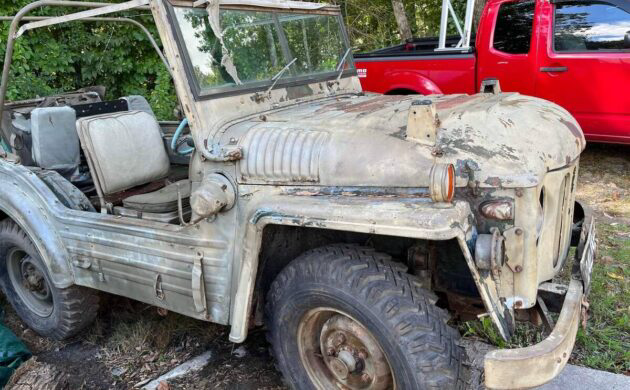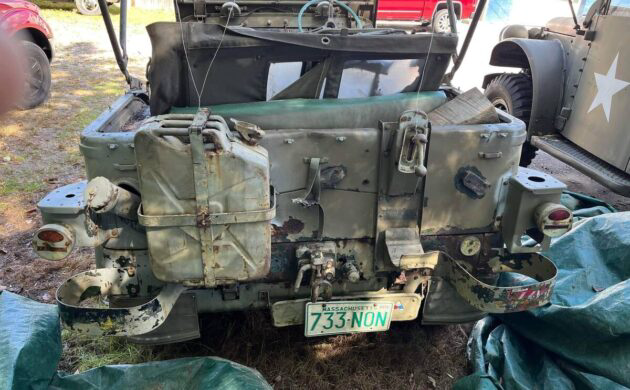Vintage military vehicles almost always have fascinating histories as it relates to how they were conceived. World War II forced almost every major world superpower to build a fleet of durable military vehicles or crib off an existing design if they didn’t have one of their own. In the case of our subject vehicle, known as an Austin Champ, this vehicle actually came to life after WWII when Britain decided they wanted a machine of their own creation. That’s why it’s the only military Jeep out there with an actual Rolls-Royce engine. Find this 1951 Austin Champ here on craigslist in Franklin, Mass. for $7,000. Thanks to Barn Finds reader Gunter K. for the find.
Given how many collectors have assortments of vintage military vehicles and memorabilia, it’s not entirely surprising to see a backyard full of vintage trucks in olive green paint. Of course, I’d still love to find out more about how this Austin ended up stateside and in a metro Boston backyard. The Austin appears to be loaded up with all the bolt-on accessories that come on a military rig, from the extra gas cans to various straps and mounting locations. The seller is also including a trailer that looks like it came with the Austin when it was new; he calls it “very rare” so perhaps it is an OEM piece.
The interior, spartan as it is, is in good order. With no roof, you have to wonder if exposure to rain and snow has done any damage to the floors. I highly doubt you can all up Rock Auto and get replacement pans for a truck like this, but these military rigs are so rudimentary that you likely don’t need to fret about getting the panels perfect. The Austin appears largely complete inside with what looks like an OEM steering wheel, factory gauges and seats, and gear shift. According to Silo Drome, the transmission is an “….all synchromesh five speed unit,” and is connected to a “….Borg and Beck clutch with a mechanical linkage.”
Here’s the “rare” trailer that looks like a perfect accessory for a military rig like this. If this is an OEM piece, it’s pretty amazing that it has somehow remained with the Austin all these years. The engine is likely a Rolls-Royce B40 setup, and the earliest models had engines built by Rolls-Royce at the Crewe factory. Later examples were fitted with engines built by Austin according to the Rolls-Royce design, and were completely waterproofed – that is, the engine, transmission, and electrical system could withstand being driven in water up to a depth of six feet. Overall, this looks like a fun rig to rip around in if you have access to some open spaces with minimal oversight from the game warden.





Well, well, what’s all this then? Silly Americans, in proper British terms, it’s a “Truck, 1/4 ton, 4×4 CT, Austin Mk.1”, and don’t you forget it. I read, Britain used Willys Jeeps in Da Big One, not sure if this vehicle actually saw any combat, but Britain wasn’t going to be caught with their pants down again. No question, it’s a stout unit. About as useful as a Willys MB today, but you’ll clearly have the only one. I agree, how it got here is the real mystery.
British never made a Jeep.
Sure they did, the Land Rover.
There was a junkyard on the South side of Akron Ohio near the Blimp hangar that had 20 or 30 of these. I bought a lot of parts like coils and D lamps that fit the MG TC. Lucas stuff for cheap. Drove by it recently and everything is now gone. Never found one driven on the road. They were really over built. Cheers
I remember an article where the original designer drove one of these across Europe to Asia in the 1950s, in a demonstration of it durability. No idea why this vehicle failed to sell to the British army. The designer boasted that the chassis was sealed so internal rusting was not likely. Having owned a Landrover military vehicle; its existence was terminated by persistent chassis rot internally.
I’m sure they were used by the British Army!Overengineered and very thirsty.
Unusual to say the least.
Would the British Jeep not be a Land Rover?
@Luke Arnott is corrrct. The British military did buy the Champ, but it was less good in value than the Land Rovet. And why have 2 radically different supply chains involved?
Totally agree; the British Jeep just has to be the Land Rover! The Champ must be more like the British equivalent to the M151 Mutt.
Some vehicles like the Jeep stay in service much longer than planned, but military vehicles are not designed with longevity in mind.
Quite a few of these downunder , as the Australian army had them .
The. Rolls Royce engine is a 4 cyl B40 .
These were a modular unit , also available in 6 & 8 cyl variants . The transmission set up is interesting , the gearbox driving through some sort of transfer setup giving the Champ the same no of reverse gears as forwards !
Great for retreating !
Still lots of mechanical spares available for these .
While the engine in the Champ was indeed a Rolls-Royce unit, it was NOT the same as used in the Rolls-Royce automobiles. The company had another division that designed and manufactured all types of engines for industrial and commercial use, from Aircraft jet engines to tiny 1 cylinder generator motors.
This looks so cool, but that front end is fugly.
Jeeps are American made.
Longevity is sometimes not a military requirement. Story is that some Russian tanks, now in use, designed for a life of 300 hours.
Charlie,
During WW2 the average life expectancy of the Jeep was 90 days of combat. In some battles, tanks [of all sides] had a battle life of a few minutes before it was out of commission. Sherman tanks were estimated to have such a short life that they were not equipped with a crew’s cabin heater, but they were later given a tiny Coleman heater for heating coffee or food ration tins!
No one has mentioned the fact that these had a separate lever to the reverse gear in the combined transfer box / rear differential so they had 5 speeds in both forward and reverse – sounds like a Italian Military vehicle spec :-) And while the engine Bill was not used in Rolls Royce automobiles, its origins goes back to designs for a car motor. Quite a few made their way out here to NZ and a few still exist in Museums, etc.